Overview
The article articulates how augmented reality (AR) automotive solutions are revolutionizing car buying experiences by offering immersive, interactive tools that significantly enhance customer engagement and satisfaction. Research indicates that these technologies are not merely enhancements; they are transformative.
Applications such as:
- Virtual showrooms
- Interactive test drives
exemplify how AR can streamline the purchasing process, leading to increased sales and diminished buyer's remorse. These proven strategies are reshaping the automotive landscape, inviting brand managers to consider the immense potential of AR in their sales tactics. Embracing these innovations is not just an option; it is a necessity for staying competitive in a rapidly evolving market.
Introduction
The integration of augmented reality (AR) into the automotive industry is fundamentally reshaping the car-buying experience, transforming what was once a daunting process into an engaging and interactive journey. By leveraging cutting-edge AR solutions, potential buyers can:
- Visualize vehicles within their own environments
- Customize features
- Embark on virtual test drives—all from the comfort of their homes
However, as the automotive landscape continues to evolve, it is crucial to consider the challenges and opportunities that lie ahead for both dealerships and consumers in this rapidly changing market.
Magic Playbox: Enhancing Car Buying with Immersive AR Experiences
Magic Playbox harnesses the power of augmented reality to revolutionize the car buying experience, enabling potential buyers to visualize vehicles in their own environments. Through advanced AR applications, users can interact with detailed 3D models, customize features such as paint colors and accessories, and even simulate test drives from the comfort of their homes. This immersive method captivates users and significantly boosts client satisfaction; research indicates that AR can reduce return rates and increase overall engagement by up to 80%.
By offering a distinctive and unforgettable shopping experience, Magic Playbox effectively boosts sales and cultivates loyalty among clients, establishing itself as a leader in the AR landscape for vehicles. Case studies, such as USAA's AR app, demonstrate that dealerships employing AR technology report greater client engagement and diminished buyer's remorse, underscoring the transformative effect of these innovative solutions on the vehicle sales process.
Furthermore, the vehicle AR market is projected to grow significantly, underscoring the relevance and future potential of AR in the industry.
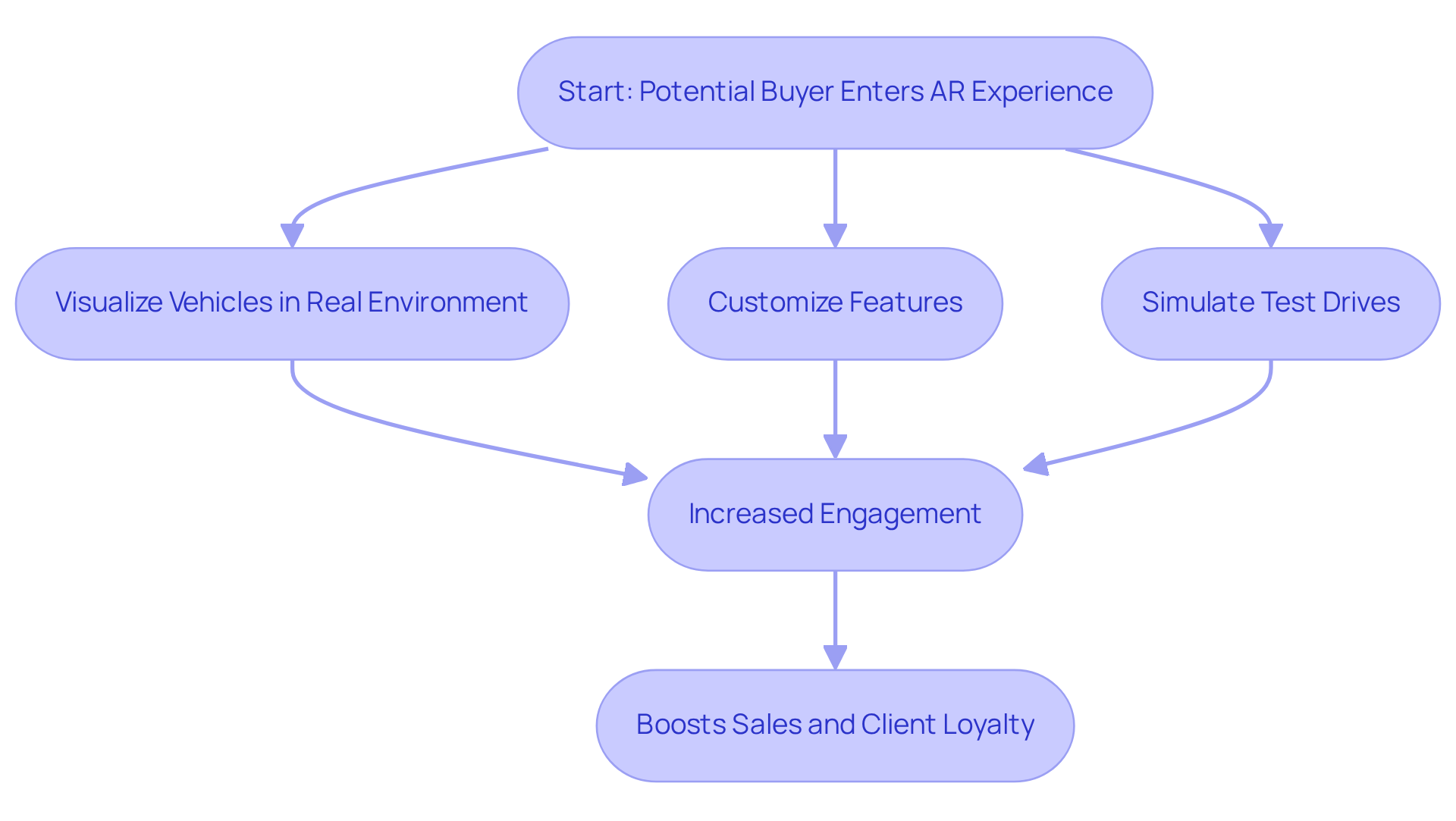
Impel AI: Personalizing Customer Engagement in Automotive Sales
Magic Playbox harnesses advanced augmented reality (AR automotive) technology to revolutionize engagement within the automotive and fashion sectors. By crafting immersive experiences that allow clients to visualize products in real-time, Magic Playbox empowers brands to deliver highly personalized interactions. This innovative strategy not only enhances the buying journey but also cultivates a profound connection between consumers and brands.
With tailored AR automotive interactions, clients can explore features and styles in a manner that feels both intuitive and captivating, ultimately driving conversion rates as they develop a stronger affinity for the brand's offerings. Moreover, Magic Playbox's solutions refine the purchasing process in the AR automotive sector by integrating interactive content that captivates users, rendering their experiences with vehicle and fashion brands more pertinent and enjoyable.
Vection Technologies: Leveraging AR for Automotive Design and Customer Experience
Magic Playbox is at the forefront of leveraging augmented reality in AR automotive to revolutionize design processes and improve user experiences. By allowing designers to visualize transportation configurations in real-time, AR greatly accelerates the design cycle and minimizes errors. This technology not only simplifies the development process but also empowers users to engage with design concepts through immersive AR applications created by Magic Playbox. Such engagement enhances their understanding and appreciation of the vehicles, fostering a seamless experience that benefits both manufacturers and buyers.
Statistics indicate that AR can lead to a reduction in development time by as much as 30%, while simultaneously enhancing client satisfaction and engagement levels. Case studies reveal that vehicle brands employing AR automotive in their design processes, particularly those adopting Magic Playbox's innovative solutions, have witnessed increased interest and improved sales rates. This underscores the dual benefits of efficiency and enhanced user engagement. The integration of AR into both design and client interaction exemplifies how the vehicle industry is evolving to meet contemporary consumer expectations, with AR applications becoming increasingly vital for enriching client engagement.
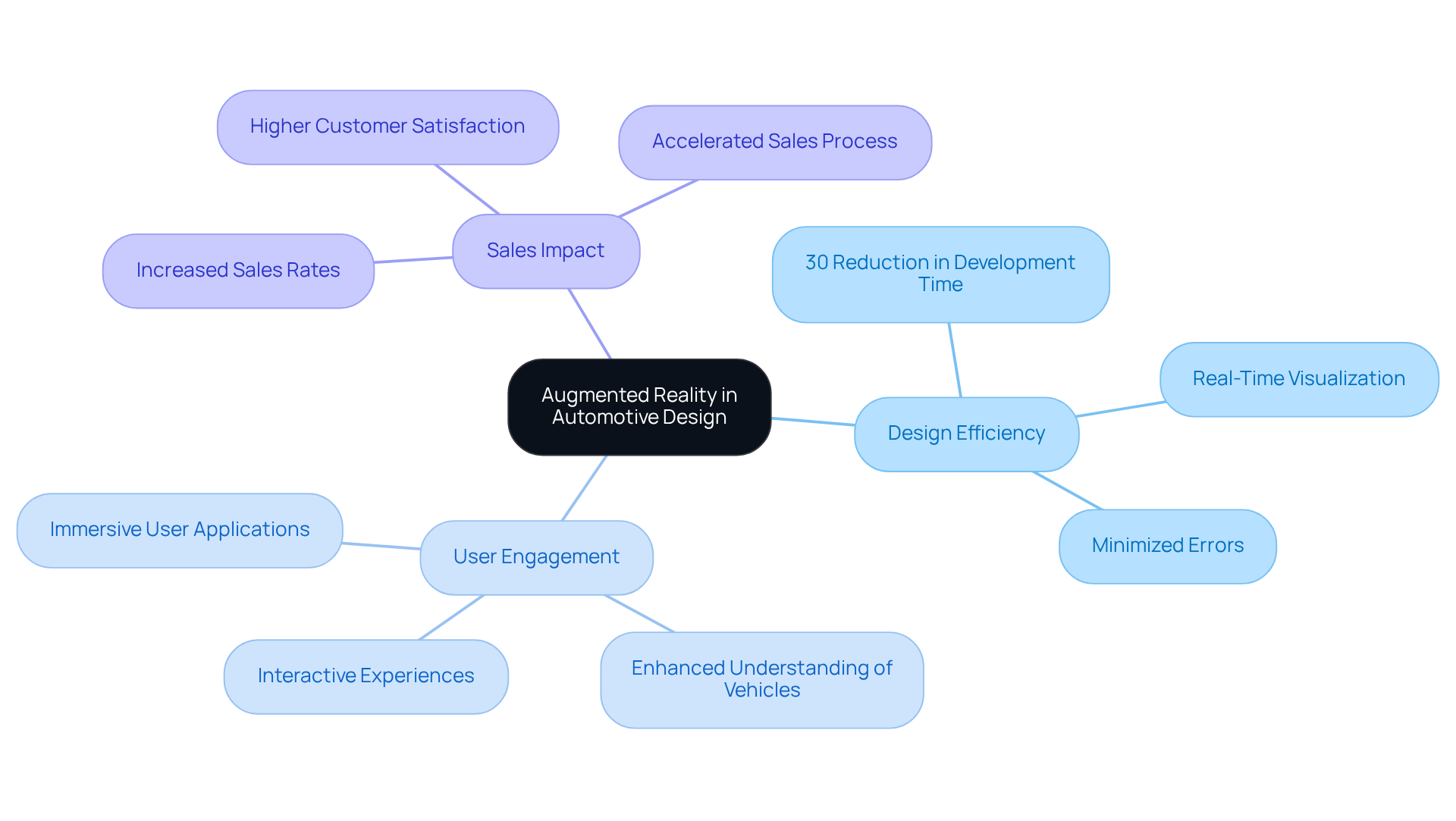
AR Training Solutions: Elevating Automotive Sales Staff Competence
Augmented reality (AR) automotive training solutions empower sales personnel by providing engaging learning opportunities that significantly enhance their product knowledge and sales techniques. By simulating real-world scenarios, AR training enables employees to hone their skills in a risk-free environment. This practical approach not only boosts their confidence but also equips them with essential tools to effectively connect with clients. Consequently, dealerships witness increased sales and improved client satisfaction.
Research indicates that AR can elevate sales by up to 80% through the integration of AR modules, underscoring the effectiveness of these training solutions. A compelling case study of Nelson Cars AR Automotive Group highlights this impact, as they successfully developed a training program that markedly improved sales and performance metrics.
By incorporating AR into training programs, dealerships can cultivate a more knowledgeable and adaptable workforce, ultimately driving superior results in a competitive market. However, it is crucial to recognize the challenges associated with AR implementation, such as technological barriers related to hardware and software compatibility. Ongoing investment in training is essential for dealerships to secure long-term success and adaptability in the ever-evolving AR automotive landscape.
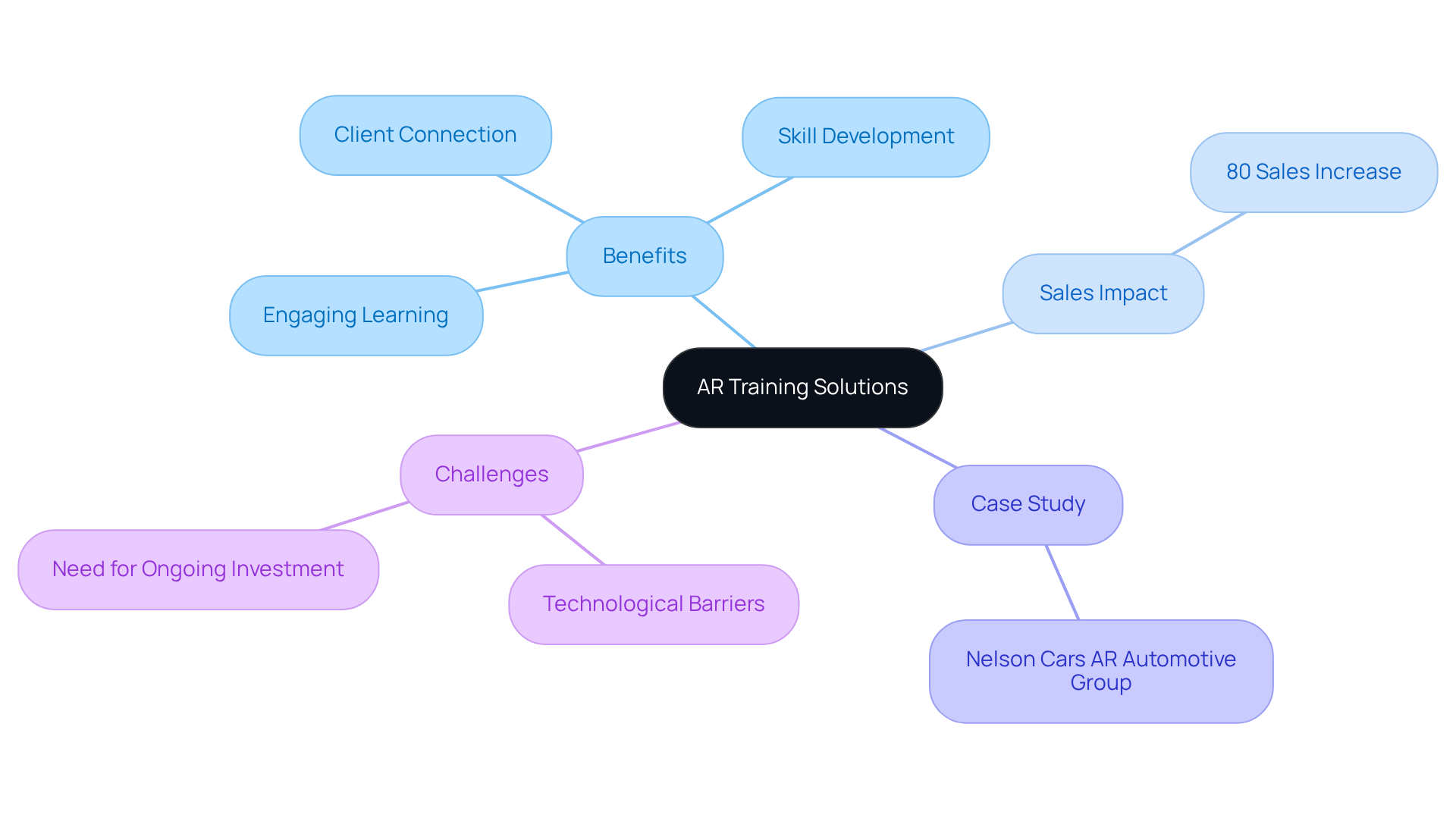
Virtual Showrooms: Transforming the Car Buying Experience with AR
Virtual showrooms leverage augmented reality to create immersive environments where customers can explore vehicles without the necessity of visiting a physical dealership. These digital platforms empower users to view cars from multiple perspectives, customize features in real-time, and even engage in virtual test drives. This innovative approach not only aligns with the preferences of modern consumers but also significantly enhances the overall car purchasing process.
Research indicates that dealerships embracing virtual reality showrooms and augmented reality test drives have reported a remarkable 20% increase in client conversions compared to traditional sales methods. By offering a convenient and engaging shopping experience, virtual showrooms are redefining consumer interactions with vehicle brands, making the car-buying process more efficient and enjoyable.
Successful applications, such as those by Mercedes-Benz and Volkswagen, demonstrate how AR automotive technology can revolutionize the exploration of automobiles, enabling clients to customize their selections and visualize their ideal cars in a vibrant digital environment. As the automotive retail landscape continues to evolve, the integration of AR automotive in virtual showrooms is proving essential for enhancing client engagement and satisfaction.
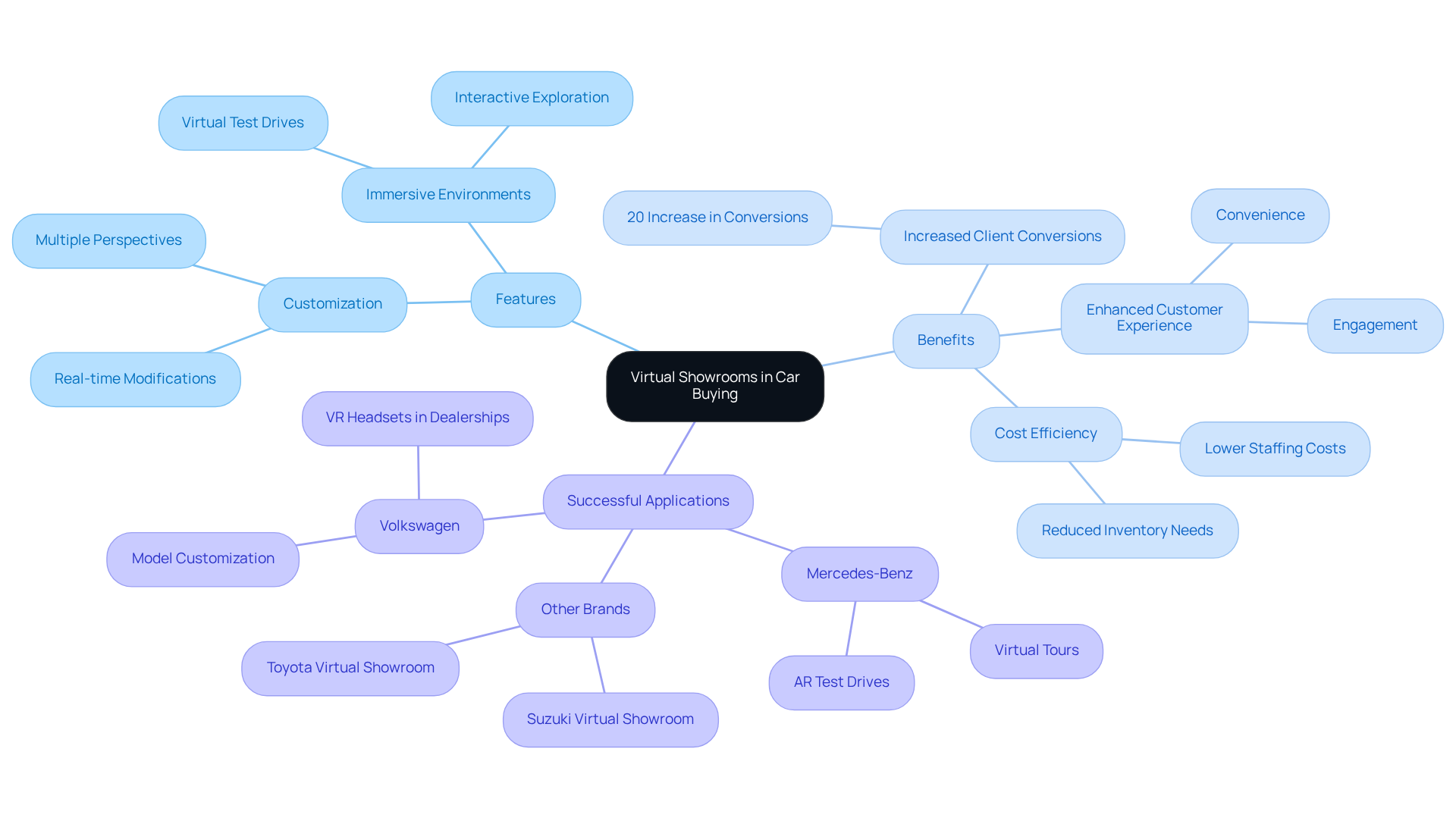
Interactive Test Drives: Engaging Customers with Real-Time AR Visualizations
Interactive test drives powered by augmented reality (AR) are revolutionizing the way clients experience automobiles, enabling them to engage in a simulated environment from the comfort of their homes. By overlaying real-time data and visualizations, potential buyers can assess vehicle performance, features, and handling without the necessity of physical travel. This innovative approach not only enhances accessibility but also equips users with valuable insights, significantly improving their decision-making process.
Statistics indicate that dealerships utilizing AR for interactive test drives report a substantial increase in client engagement, with studies suggesting that such experiences can boost sales by as much as 80%. Furthermore, AR visualizations simplify complex automotive features, providing instant information that mitigates buyer's remorse and enhances overall satisfaction.
Case studies underscore the effectiveness of AR in transforming test drives. For instance, dealerships that have implemented AR solutions have observed a 20% increase in client conversions compared to traditional methods. By allowing users to envision how a car integrates into their lifestyle, AR alleviates decision anxiety and fosters a stronger connection with the vehicle.
As the AR automotive sector continues to adopt AR technology, the future of test drives looks promising, featuring immersive interactions that not only captivate buyers but also streamline the car purchasing process. Magic Playbox is at the forefront of this transformation, pioneering immersive AR interactions that elevate brand engagement and consumer loyalty.

AR Information Overlays: Empowering Informed Car Buying Decisions
Augmented Reality (AR) information overlays significantly enhance the car buying experience by delivering real-time data directly to individuals as they explore vehicles. This innovative technology empowers potential buyers to seamlessly view essential specifications, pricing, and feature comparisons integrated into their field of vision.
For example, Magic Playbox's advanced AR solutions allow buyers to visualize 3D models of cars in their own driveways, facilitating assessment of how different models fit into their lives before making a purchase. Prompt access to vital information not only enables clients to make informed decisions but also mitigates uncertainty, ultimately bolstering their confidence in the buying process.
As the automotive industry increasingly embraces AR automotive solutions, the market for AR automotive is projected to surge from 4.51 billion USD in 2021 to an impressive 14.4 billion USD by 2028, indicating a significant shift towards integrating AR technology in consumer interactions.
Case studies, such as Toyota's AR app that projects drivetrain images onto vehicles in showrooms, illustrate how these overlays enhance understanding and engagement, resulting in improved sales outcomes. By incorporating AR information overlays, dealerships can cultivate a more interactive and informative environment, profoundly influencing buyer purchasing decisions.
E-commerce brand managers must consider leveraging Magic Playbox's AR technology to elevate their customer engagement strategies, ensuring they remain at the forefront of this evolving market.

AR Marketing Campaigns: Captivating Automotive Consumers
AR automotive marketing campaigns are revolutionizing the industry by providing consumers with interactive and immersive experiences. Leveraging augmented reality, brands empower potential buyers to visualize automobiles in their own environments, explore intricate features, and customize options in real-time. This heightened level of engagement not only captures attention but also cultivates a deeper emotional connection with the brand. For instance, BMW's AR showroom app enables users to interact with true-to-size 3D models of cars, facilitating immediate configuration changes and enhancing customer satisfaction. Similarly, Hyundai's Virtual Guide transforms the ownership process into an educational journey, allowing drivers to scan their vehicles for detailed AR instructions on features and maintenance.
Magic Playbox is leading this transformation, pioneering immersive AR interactions that boost brand engagement and consumer loyalty. By developing tailored AR automotive solutions for brands, Magic Playbox enables companies to create unique marketing campaigns that resonate with consumers. The emotional involvement encouraged by these interactive experiences is considerable; research indicates that 88% of companies using AR reported enhanced business efficiency, while 71% noted improved client engagement. This emotional connection is vital, as it drives sales and cultivates customer loyalty. Brands like Mercedes-Benz have also embraced AR, launching apps that allow users to visualize their first fully electric SUV, the EQC, at full scale, thereby reassuring potential buyers about their investment in electric mobility.
As the automotive landscape evolves, the integration of AR automotive into marketing strategies is becoming essential. Successful campaigns not only enhance consumer experiences but also lead to tangible increases in sales, demonstrating the power of interactive AR advertisements in transforming car buying experiences.
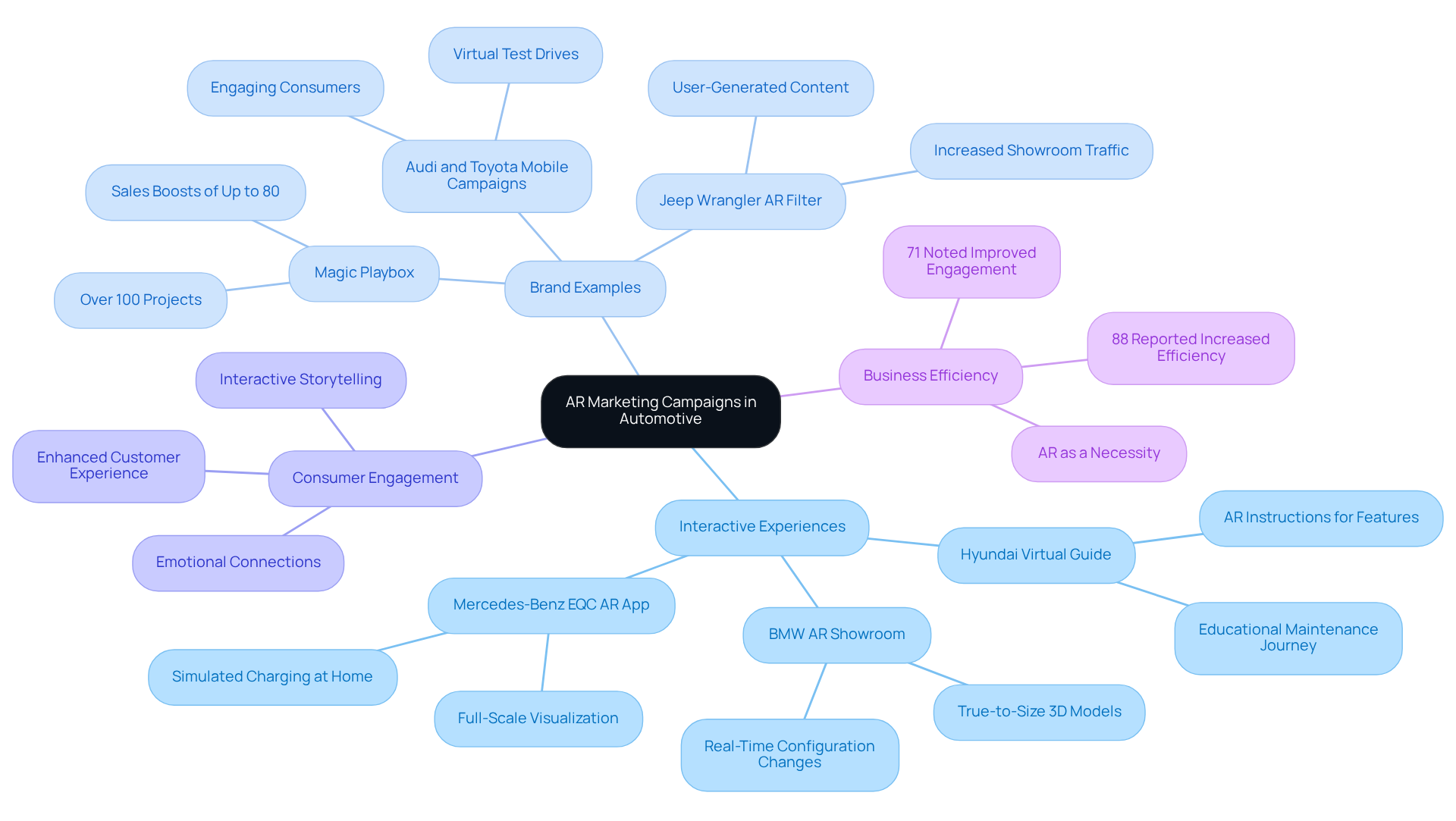
Remote Inspections: Streamlining Vehicle Assessment with AR
Remote inspections powered by AR automotive technology revolutionize the assessment process of automobiles, enabling technicians to conduct evaluations from a distance. By leveraging AR technology, inspectors can superimpose diagnostic information onto vehicles, enabling the identification of issues without the need for physical presence. This innovative approach not only conserves time and resources but also significantly enhances accuracy, leading to more efficient service and heightened client satisfaction.
Embracing AR automotive technology in remote inspections is not just a trend; it is a proven strategy that aligns with industry standards and meets the evolving needs of automotive service providers.
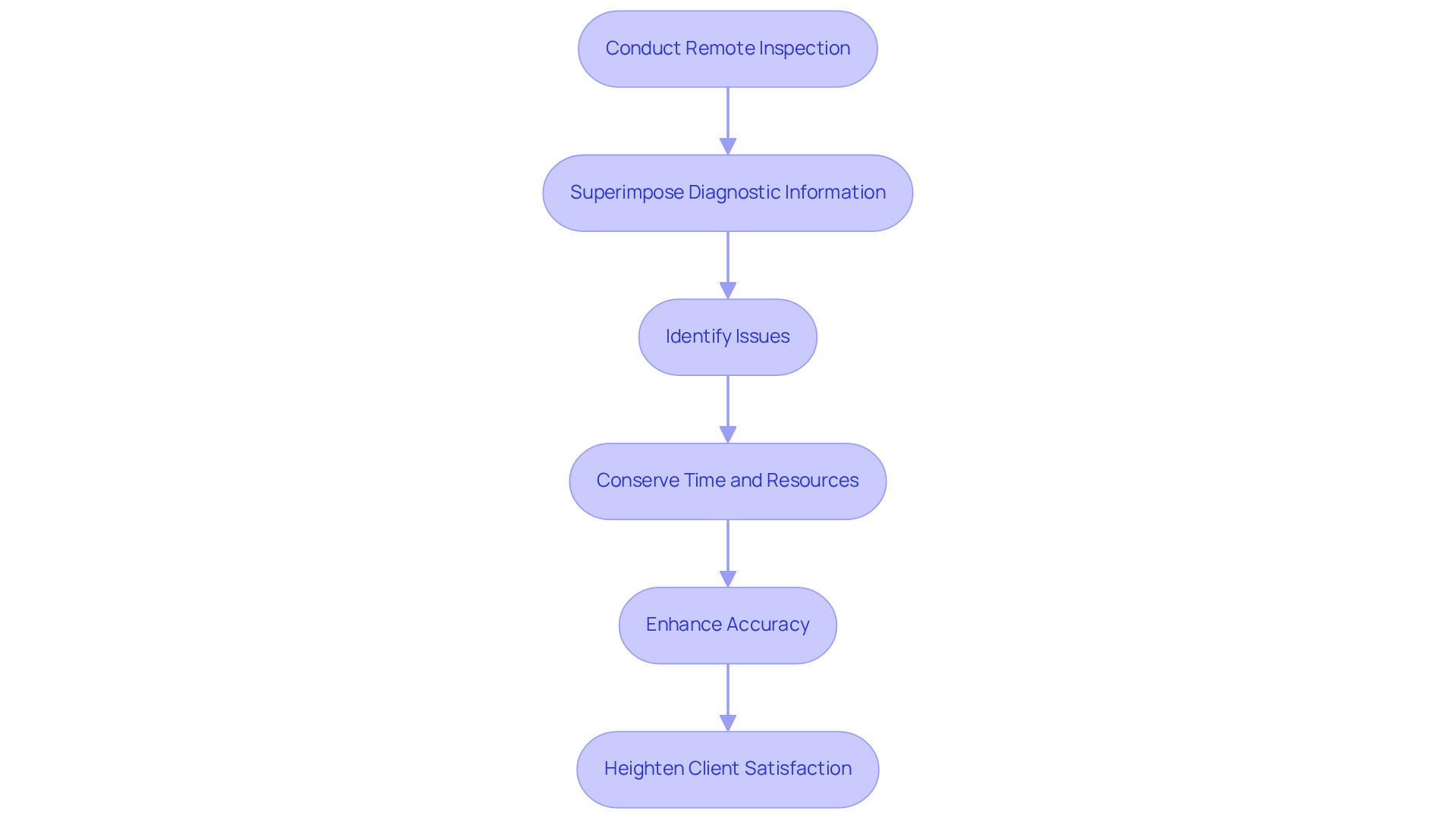
E-Commerce Integration: Enhancing Online Car Buying with AR Solutions
E-commerce integration with augmented reality solutions significantly enhances the online car purchasing process, enabling customers to visualize automobiles in their own environments. Through AR applications, buyers can assess how various models fit into their spaces, customize features, and even simulate driving experiences. This innovative approach not only makes online shopping more engaging but also instills greater confidence in purchasing decisions, particularly among younger generations who are notably more inclined to buy automobiles online.
In fact, research indicates that 21% of car buyers completed their purchases entirely online by 2023, a trend accelerated by the pandemic that has transformed consumer behavior. As the automotive market continues to evolve, the integration of AR automotive technology is poised to drive sales and enhance customer satisfaction in the digital marketplace.
For instance, USAA's pilot AR application, utilizing Blippar's technology, allows users to identify automobiles from the year 2000 or later and access real-time information, thereby improving the overall car purchasing process. By leveraging AR, brands can create immersive experiences that resonate with consumers, ultimately leading to increased sales and loyalty. Furthermore, the convenience of online car shopping empowers consumers to browse vehicles at their own pace, further amplifying the appeal of AR in the car buying process.
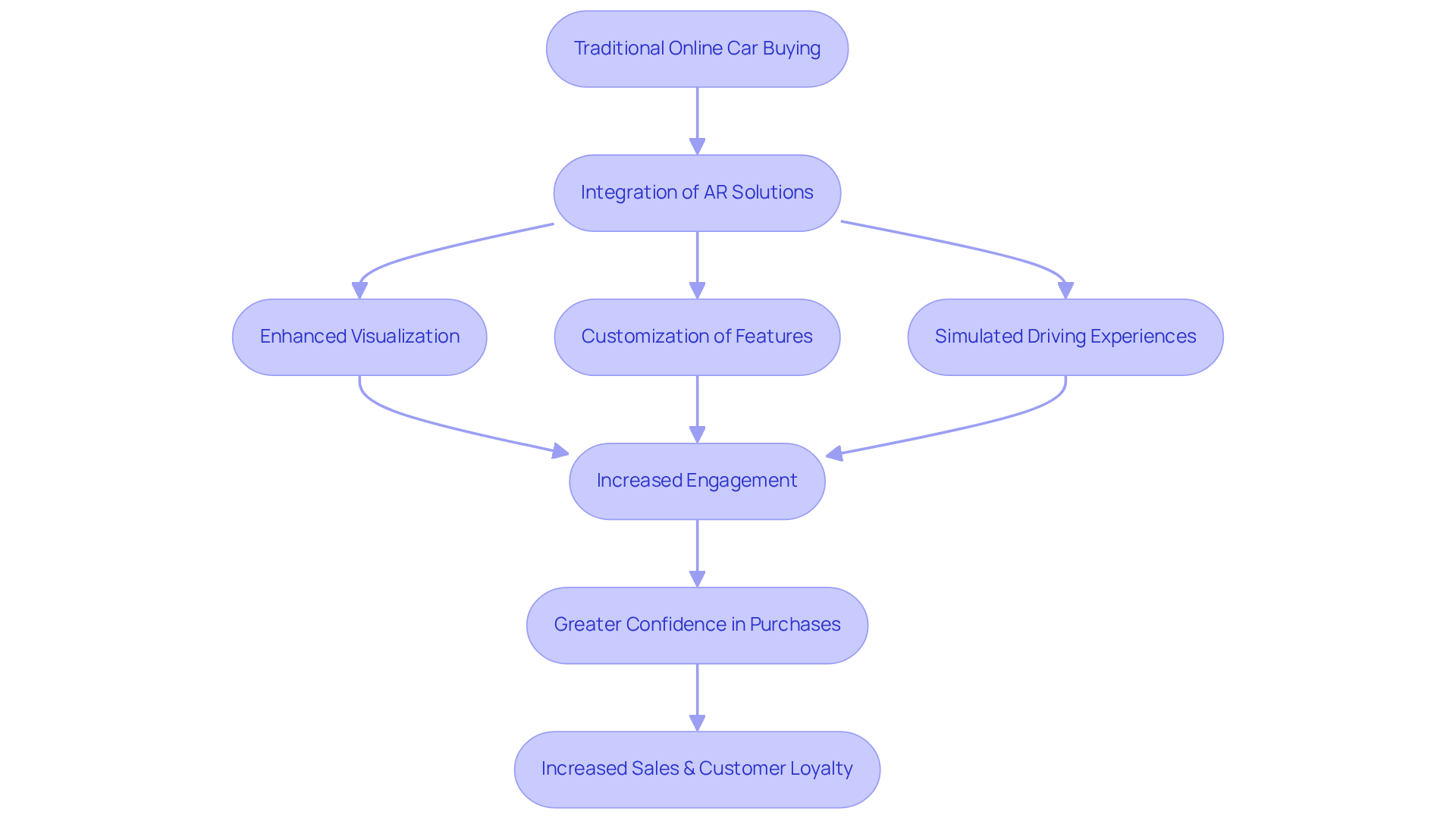
Conclusion
The integration of augmented reality (AR) into the automotive sector is fundamentally transforming the car buying experience, making it more engaging, efficient, and customer-focused. By leveraging AR technologies, brands are enhancing vehicle visualization, personalizing interactions, and streamlining processes, ensuring that customers feel connected and informed throughout their purchasing journey.
Key insights from the article highlight how AR solutions—such as immersive test drives, virtual showrooms, and interactive training programs—significantly boost client engagement and satisfaction. The use of AR allows potential buyers to visualize cars in their own environments, customize features, and access real-time information. This ultimately leads to reduced return rates and increased sales. Furthermore, AR marketing campaigns foster emotional connections between consumers and brands, reinforcing loyalty and driving business efficiency.
As the automotive industry continues to evolve, embracing AR technology is crucial for dealerships and manufacturers aiming to meet the demands of modern consumers. The future of car buying lies in creating immersive, user-friendly experiences that facilitate informed decisions and enhance overall buyer satisfaction. By investing in AR solutions, automotive brands can position themselves at the forefront of innovation, ensuring they remain competitive in an increasingly digital marketplace.
Frequently Asked Questions
What is Magic Playbox and how does it enhance the car buying experience?
Magic Playbox utilizes augmented reality (AR) to transform the car buying experience by allowing potential buyers to visualize vehicles in their own environments, interact with detailed 3D models, customize features, and simulate test drives from home.
How does augmented reality improve customer satisfaction in car buying?
AR significantly boosts client satisfaction by providing an immersive shopping experience that captivates users, leading to reduced return rates and increased engagement by up to 80%.
What are the benefits of using AR technology in automotive sales?
AR technology enhances engagement, reduces buyer's remorse, and fosters loyalty among clients, ultimately driving sales and improving the overall vehicle sales process.
What evidence supports the effectiveness of AR in automotive sales?
Case studies, such as USAA's AR app, show that dealerships using AR technology report greater client engagement and diminished buyer's remorse.
What is the projected growth of the vehicle AR market?
The vehicle AR market is expected to grow significantly, highlighting the relevance and future potential of AR in the automotive industry.
How does Magic Playbox personalize customer engagement in automotive sales?
Magic Playbox creates immersive experiences that allow clients to visualize products in real-time, enhancing the buying journey and fostering a deeper connection between consumers and brands.
What impact does AR have on the automotive design process?
AR accelerates the design cycle by allowing designers to visualize configurations in real-time, reducing development time by up to 30% and minimizing errors.
How does user engagement with AR applications benefit manufacturers and buyers?
Engaging users with AR applications enhances their understanding and appreciation of vehicles, leading to a seamless experience that benefits both manufacturers and buyers.
What are the dual benefits of integrating AR into the automotive industry?
The integration of AR into automotive design and client interaction leads to increased efficiency in design processes and enhanced user engagement, resulting in improved sales rates.




